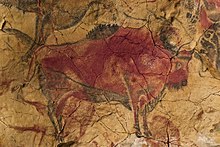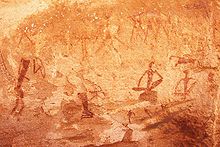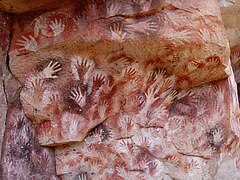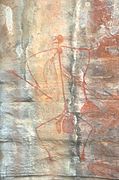Rock painting
A rock painting is a drawing or sketch that exists in some rocks or caverns, especially prehistoric ones. The term “rupestrian” derives from the Latin rupestris, and this from rupes (rock). So, in a strict sense, rock art would refer to human activity on the walls of caves, covachas, rock shelters and even cliffs or another instrument (ravines, among others). In this regard, it is practically impossible to isolate pictorial manifestations from other representations of prehistoric art such as engravings, sculptures and petroglyphs, engraved on stone by percussion or abrasion. Being protected from erosion by the nature or location of the support, the cave paintings have resisted the passing of the centuries.
This is one of the oldest artistic manifestations of which there is evidence, since, at least, there are testimonies dated up to 40,000 years old, that is, during the last ice age. However, in mid-September 2018, researchers from the University of the Witwatersrand in South Africa found a stone containing Paleolithic drawings that exceed those known to date. It is estimated that they were recorded around 73,000 years ago. The most famous rock paintings (in caves) in the world, in Lascaux, France and Altamira, Spain, were found by children. Carbon dating shows that the paintings at Lascaux are 20,000 years old, while those at Chauvet, in the French part of the Ardèche, are almost twice as old.
On the other hand, although cave painting is essentially a prehistoric expression, it can be located in almost all periods of human history and on all continents, except Antarctica. The oldest manifestations and the most relevant are found in Spain and France. They correspond to the transition period from the Paleolithic to the Neolithic.
These paintings and the other associated manifestations reveal that human beings, since prehistoric times, organized a system of artistic representation. It is generally believed that it is related to magical-religious practices to promote hunting. Given the chronological and geographical scope of this phenomenon, it is difficult, if not impossible, to propose generalizations. For example, in certain cases the cave works occur in remote areas of the cave or in places that are difficult to access; there are others, on the other hand, in which they are in sight and in clear and expeditious areas. When the decoration is separated from the sites occupied by the settlement, the concept of sanctuary arises, whose latent character underscores its religious or non-daily significance. In the cases in which the painting appears in domestic contexts, it is necessary to reconsider this notion and consider the complete integration of art, religion and the daily life of the primitive human being.
Data
- The paintings in Cognac, France, they were painted over a period of 10,000 years.
- It's possible that the caves were the temples of prehistoric times and the paintings were related to religious rituals.
- Most of the paintings in caves show large animals like bison, deer, horses and mammoths.
- The artists of the caves They often painted spitting the painting, a practice that was also performed by the Aboriginals of Australia.
- To get to the paintings 14 000 years old in Cueva de Pergouset, France must be dragged through 150 m (meters) of passages.
- In the caves from Nerja, Spain, there are rock formations that possibly prehistoric people played as a xylophone.
- Aboriginal paintings in rocks of the Arnhem Land in the Northern Territory in Australia could be more than 50 000 years old.
Theme, colors and outstanding techniques in the paintings
Paleolithic cave paintings symbolize animals and lines. In the Neolithic, animals, human beings, figures, symbols, the environment and hands were represented, also representing the habitual behavior of communities and their interaction with the creatures of the environment and their deities. Among the main figures present in these graphs we find images of bison, horses, mammoths, deer, reindeer, etc., although hand marks also occupy a significant percentage. Animals wounded with arrows are frequently shown. The motifs and materials with which the different cave paintings were made are very similar to each other, despite thousands of kilometers away and thousands of years in time. All the human groups that depended on hunting and gathering fruits carried out this type of pictorial work.
Cave paintings typically used one or two colors, including some black, red, yellow, and ochre. The colors, also called pigments, were of vegetable origin (such as charcoal), bodily fluids and waste (such as feces), mineral compounds (such as hematite, clay, and manganese oxide), mixed with an organic binder. (resin or fat).
The caves are located completely inside the terrain and the paintings are in areas of complete or almost complete darkness. It is believed that the ancient artists helped themselves with small stone lamps fed with marrow.
The colors were smeared directly with the fingers, although the paint could also be spit on the rock, or fine lines of paint were blown with a hollow reed. Sometimes the powdered pigments were rubbed directly on the wall and also, they could be mixed with some binder and applied with reeds or rudimentary brushes. Burnt branches and balls of mineral coloring bound with resin were used as pencils. Sometimes unevenness and cracks in the wall were used to give the sensation of volume and realism.
Often the animal silhouettes were scored or scratched to create incisions to produce a more realistic and noticeable outline in the rock.
The age of the paintings remains a big question mark in many archaeological sites, since the methods to determine it, such as carbon-14, can easily lead to erroneous results due to the contamination of the material evaluated and also because the caves and Rocky surfaces present protuberances in which dirt residues from different eras are lodged. To determine the date of its creation, more conventional techniques are used, such as dating images by the subject represented. For example, the reindeer drawn in the Spanish cave of Las Monedas cave, whose estimated origin corresponds to the last ice age. Cave painting sites occur most frequently in France and Spain.
Africa
In Ukhahlamba-Drakensberg, South Africa, there are paintings dating back approximately 3,000 years, attributed to the San tribes, who settled in the region about 8,000 years ago. These paintings show human beings and animals and are possibly related to magical practices to promote hunting.
The largest number of rock paintings on the African continent are found in the Twyfelfontein region of Namibia. On the outskirts of Hargeisa, Somalia, paintings showing the ancient inhabitants herding cattle have recently been discovered. Other paintings can be found in the caves of the Tassili mountains, in the southeast of Algeria, in Akakus, and in other regions of the Sahara such as the Ayr mountains. Also in Tibesti, Chad and Niger.
In the region of Fezán and in the south of Algeria, three phases of the elaboration of cave paintings can be distinguished:
- First phase or primitive: originated in approximately 10,000 BC, in this period wild animals and hunting scenes are represented that prove the existence of hunter villages and a different climate environment.
- Second phase or pastoral: paintings with images of pets, especially bovines, show the breeding and domestication of them; later the horse appears.
- Third phase or Garamantic: in 2000 B.C.; so called by the people of the guarantors who lived the Fezzan. There are representations of the dromedary, which concludes that the desert predominated on the continent.
There are also some 3,500-year-old paintings in the Sahara desert (although it is being looted and vandalized). And it seems that the Phoenicians established colonies on the coast of what is now Western Sahara in the time of Hanno the Navigator, but they vanished without a trace.
North America
In North America, the presence of rock art includes from Alaska, Canada, the United States and Mexico with paintings from the lithic era, in Alaska, from the ice age in Canada, to Florida with representations of mammoths dating back to between 13,000 to 20,000 years; from California and Sonora in Oasisamerica, to Mesoamerica, passing through Aridoamerica.
Canada
Multiple rock art sites can be found in Canada. Thus in Bow Valley Park with paintings from 500 years to 1,300 years old, Higwoods in Alberta with more than 300 years, Peterborough Petroglyphs Provincial Park, is designated as a national historic site, known by indigenous peoples as Kinoomaagewaabkong or The Teaching Rocks. We can also find Canadian rock art in the Áísínai'pi Stone Writing Park, A whole scenario exists for the pictographs and petroglyphs of the Wuikinuxv Territory, Dinosaur Provincial Park
United States
In the United States, rock art has large concentrations in Oasisamerica, Utah, Arizona, California, although they can be found in Aridoamerica in Texas, Florida, and other states.
Thus we see art in the Sierra del Coso in California, Lower Pecos Canyonlands National Park in Texas, Coso Range Rock Art in California, Moab Utah, 900 to 2,000 years old. In Arizona we find the Sears Point site, near Yuma, as well as in Ajo
Mexico
Rock art in Mexico, as in other North American countries, and in the world is multiple and diverse. We can find them in the states of Baja California Sur, Baja California, Sonora, Sinaloa, Chihuahua, Nuevo León and in almost all the states of the country, including some states of Mesoamerica, such as Guanajuato, Hidalgo, Oaxaca and Yucatán.
South America
In South America, the continental extension and the multiplicity of prehistoric environments and cultures make an abstraction that allows generic characterization difficult.
- In Paraguay, a series of paintings have been described in the area of Amambay, specifically at the Jasuka Venda hill or Guasú hill, a place considered sacred for the Pai Tavyterá ethnic group, dating approximately 5000 years.
- In Chile, they have determined nine styles closely related to the different geographical regions.
- In Peru, they have established 14 stylistic models of paintings, engravings and geoglyphs including the famous and enigmatic lines and geoglyphs of Nazca and Pampas de Jumana.
- Bolivia raises five periods, and four main areas have been described in Venezuela.
- In Ecuador, three major areas have been defined in the eastern area.
- In Colombia, the largest number of cave paintings have been found in the rocky coats of Chiribiquete; the oldest ones dated in 19 510 years AP. There has also been a large concentration of paintings in the Cundiboyacense altiplano, although it also occurs in other areas of the Eastern Cordillera and in the plains of the affluent hydrographic basins of the Amazon and the Orinoco. The most recurring color is the red ochre, but samples have been found in black, white, yellow and orange. No research has yet been done on styles or chronology data.
- In Brazil's wide expanse the last few years have seen a proliferation of archaeological discoveries that lead to stylistic and cultural variations to more than one hundred variants.
- In Argentina, four great styles or cultures of rock art are defined in the northwest of the country. Three stylistic moments are identified in Patagonia. In the central mountains of Province of Córdoba and Province of San Luis.
- In Uruguay, Consens proposes six stylistic trends. The Center for the Research of Rupestre Art of Uruguay is a non-profit scientific society that has developed research tasks since 1972 and aims to safeguard and make known national prehistoric art.
Peru
Of the 25 departments of Peru, 23 report rock art sites, only 2 do not: Tumbes, on the north coast, and Ucayali, in the Amazon jungle.
| Department | Rupest paintings | Petroglifos | Total |
| Puno | 75 | 25 | 100 |
| Huánuco | 67 | 13 | 80 |
| Cuzco | 44 | 34 | 78 |
| Arequipa | 30 | 88 | 118 |
| Pasco | 25 | 1 | 26 |
| Freedom | 24 | 33 | 57 |
| Cajamarca | 23 | 26 | 49 |
| Áncash | 21 | 21 | 42 |
| Apurímac | 19 | 13 | 32 |
| Junín | 15 | 9 | 24 |
| Amazon | 15 | 3 | 18 |
| Lima | 10 | 29 | 39 |
| Moquegua | 9 | 6 | 15 |
| Tacna | 8 | 18 | 26 |
| Huancavelica | 7 | 5 | 12 |
| San Martín | 6 | 10 | 16 |
| Ayacucho | 3 | 5 | 8 |
| Lambayeque | 1 | 17 | 18 |
| Piura | 1 | 15 | 16 |
| Mother of God | 0 | 1 | 1 |
| Loreto | 0 | 7 | 7 |
| Ica | 0 | 18 | 18 |
| Total | 403 | 397 | 800 |
Uruguay
In 1875, four years before the discovery in Europe of the Altamira paintings (initially not considered prehistoric art) a Spanish engineer Barhola Rial Posadas in Uruguay carefully copied the designs he saw on a huge stone and then added to the foot of the sheet, without any doubt, that they were "Indian designs".
After this first contribution (which marks the birth of the first stage of Uruguayan archaeology), other researchers such as Figuerido, Larrauri, De Freitas, Figueiras, Consens and Bespali, Peláez have worked, publishing, reviewing and discovering new sites in the rest of the country.
As a result of these investigations, dozens of sites with paintings and engravings are known today. The first located to the south of the Río Negro and the second to the north.
The paintings are made on the vertical walls of huge granite blocks, which emerge like great monuments in the wide undulating meadows of southern Uruguay.
About forty of these sites are still preserved today with an acceptable degree of visual perception. While in about a hundred blocks, you can hardly see the remains of what were important painted murals. Some areas of the departments of Flores, Florida and Durazno must have been, at that time, true outdoor exhibitions.
At a minimum, painting began around 2,500 years ago. There was a later period around the year 1200, where it was painted again, on the same stylistic basis of geometric figures. But now complex closed forms are used, with important variation of the internal designs.
In this period, several different techniques are also tested, such as the use of fine brushes (2 to 3 mm —millimeters—), the preparation of the surface prior to the design, positive hands and even negative painting. There is a special care not to overlap the paintings, taking care of the use of space, as a very valuable reference.
Asian
Cave paintings have been found in Thailand, Malaysia, Indonesia and India:
- In Thailand the caves are located along the Burmese-Thailand border.
- In Malaysia the oldest paintings are in Gua Tambun in Perak, dated in about 2000 years ago, and the graphs in the Niah cave in the homonymous national park, dating from about 1200 years.
- In Indonesia the caves of Maros in Sulawesi are famous for hand copies, also found in caves in the area of Sangkulirang.
- In India stands out the Bhimbetka region, an archaeological site where traces of human life of the Stone Age were found, including cave paintings of about 9000 years ago.
Europe
Iberian Peninsula
The Iberian Peninsula is one of the territories where we can find prehistoric sites from the Paleolithic period in Europe. There are some that are relevant due to their age, their uniqueness, their quality, etc. For example, the Nerja cave houses, according to studies from 2012, what could be the oldest paintings of humanity, also made by Neanderthals. One of the sites of extraordinary quality, and also the first recognized as prehistoric art, is the Altamira Cave, located in Spain. In this cavern there are about one hundred and fifty paintings, distributed on the walls and on the ceiling, but the most important place in the cave is a 5 m (meter) chamber, where the graphs were made on the uneven ceiling, thus taking advantage of the protuberances of the rocky surface to give relief to human and animal figures, especially bison —about eighteen— in a group of polychromatic graphs of great detail and realism. Altamira's compositions lack a sense of a whole and many times the images were superimposed on other older ones, a circumstance that confirms the magical-religious purpose and not merely decorative.
In the epipalaeolithic period, between Barcelona and Almería, there are rock wall decorations on the cave walls with calcareous surfaces and from over 800 to 1000 ms. no. m. (meters above sea level), made by a nomadic people. These paintings are characterized by impressive realism, considering that they were created with rustic tools. They show a stylistic development that gradually incorporates abstraction, schematic detail, and extreme dynamism. But what attracts the most attention are the anthropic motifs, including men dressed in pants, decorated with feathers and armed with bows, frequently depicting hunting scenes. The women wear skirts and are adorned with feathers.
During the Mesolithic, the human communities located on the peninsula were characterized by developing a more advanced level of artistic work by representing everyday situations such as hunting, fights, rites and ceremonies in images. The first paintings of this type were found in 1903 in Calapatá, but they also originated in the provinces of Almería, Albacete, Castellón, Valencia, Lérida and Teruel. These caves are distinguished from many others because they are mere shelters in the open air. Among the most impressive manifestations is that of El Cogul (Lérida), which represents a ceremony in which a group of women dance with skirts around a man.
In Portugal, Extremadura, Cádiz and the Sierra Morena are the most important paintings of an abstract trend, representing ideomorphic signs.
France
The production of cave paintings in France has been recorded for about 32,000 years, for example those of the Chauvet cave or those attributed to the Aurignacian culture in the Aurignac cave. They reached their maximum splendor between 14,000 and 13,000 B.C. C., in the Lascaux cave. In this cave, horses, deer and other animals are represented. The Lascaux cave paintings are characterized by having outlines marked with black, to highlight the image, and colored powders, to highlight the chromatic effects.
Oceania
Australia
A significant number of paintings have been found in Australia, the most important examples of which are in Kakadu National Park, a large collection of ochre-based paints. Ocher is a non-organic material, so it is impossible to date paintings using the radiocarbon procedure.
Contenido relacionado
Industrial Revolution
Peter Greenaway
Enrique Batiz















